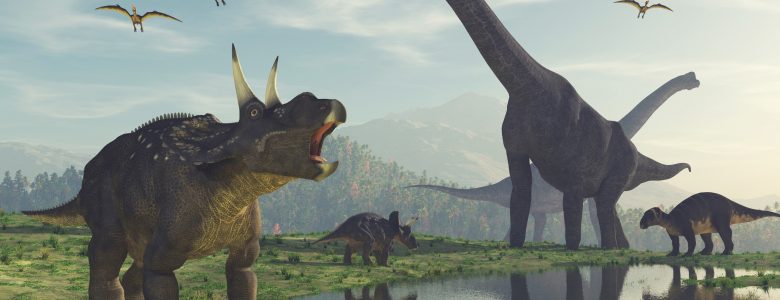August 19, 2020
Why Did Some Dinosaurs Have Cancer?

By: burgundy bug
3D Render of dinosaurs roaming a lush, mountainous landscape
Source: Adobe Stock
Cancer, one of the leading causes of death worldwide, appears to have afflicted the ferocious beasts the roamed the Earth with our prehistoric ancestors.
Earlier this month, research published in The Lancet Oncology Journal diagnosed a dinosaur with bone cancer. And this isn’t the first time researchers have made such a diagnosis based on dinosaur fossils.
Last year, National Geographic reported on a “ridiculously rare” form of bone cancer found in the hind leg of a 240-million-year-old turtle.
According to the Journal of American Medical Association study, the prognosis was remarkably similar to the type of bone cancer doctors see in human patients today.
“This study provides evidence that unregulated neoplastic cell growth occurred as early as the Triassic period and that cancer is not a modern physiological defect but rather a vulnerability that is rooted deep in vertebrate evolutionary history.”
Triassic Cancer—Osteosarcoma in a 240-Million-Year-Old Stem-Turtle | JAMA ONCOLOGY
Oh, but that’s not all. A 2003 Naturwissenschaften journal study also diagnosed tumors in duck-billed dinosaur fossils.
“The epidemiology of tumors in dinosaurs seems to reflect a familial pattern,” the study says. “A genetic propensity or environmental mutagens are suspected.”
Why Did Dinosaurs Get Cancer?
Let’s whip out Occam’s razor for a second. Perhaps the answer doesn’t lie in why dinosaurs specifically got cancer, but in the nature of cancer itself.
Cancer cells form as a result of a mutation. As a Nature article puts it, they’re “[normal] cells gone wrong — in other words, they no longer respond to many of the signals that control cellular growth and death.”
These cells that have rebelled against the vital routine of cell death and division become malignant.
“Cells become cancerous after mutations accumulate in the various genes that control cell proliferation,” the Nature article explains. “According to research findings from the Cancer Genome Project, most cancer cells possess 60 or more mutations.”
Genes, by the way, exist in almost every cell — and cells are the building blocks of all life.
The genetic code dictating the DNA of any organism’s cells is a combination of four different letters: ATCG.
Thus, genes are universal. ATCG means the same thing to you and me as it did to dinosaurs. Despite our physical differences, our cells are the same.
Read: Scientists have traced what dinosaur DNA could have looked like
National History Museum
Unlike viruses or bacteria, which must first enter the organism’s body and colonize to elicit an infection, cancer is the result of the organism’s own cells malfunctioning.
And again, every living organism has cells. All life is vulnerable to mutation — although some genes do increase the risk of such mutations occurring… And it’s worth noting that some animals, such as naked mole rats, are actually cancer-resistant.
So, while we can’t necessarily say what caused the mutations in dinosaurs, we can at least see why the mutations were possible — at least, theoretically, from the perspective of Occam’s razor.
Interested in having content featured in an upcoming blog post or issue of The Burgundy Zine? Head on over to the submissions page!
For all other inquiries, please fulfill a contact form.


